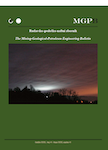Assessment of stream sediments pollution by potentially toxic elements in the active mining area of Okpella, Edo State, Nigeria
DOI:
https://doi.org/10.17794/rgn.2019.2.5Keywords:
enrichment factor, geoaccumulation index, mining activities, pollution, potentially toxic elementsAbstract
An active gold mining area in Okpella, Edo State, Nigeria was studied to assess the contribution of gold mining to the concentrations of potentially toxic elements (PTEs) in stream sediments. Standard geochemical sampling and sample treatment techniques were employed, and samples were analysed using the energy dispersive X-ray fluorescence (XRF) method. The concentrations of arsenic (As), cobalt (Co), chromium (Cr), copper (Cu), mercury (Hg), nickel (Ni), lead (Pb) and zinc (Zn) were determined in fifteen stream sediment samples from an active gold mining area, which also receives discharged marble mine water. The enrichment factor (EF) and geoaccumulation index (Igeo) were calculated using the XRF analysis results to assess the level of PTE pollution in the area. The sediments showed a PTE concentration trend of Cu > Zn > Pb > As > Cr > Hg > Ni > Co. The EF results revealed extremely severe enrichment of Hg, moderate enrichment of Cu, minor enrichment of As and Pb, and no enrichment of Co, Cr, Ni and Zn in the sediments. The Igeo also showed that the sediments were extremely polluted with Hg, moderately polluted with Cu but there was no evidence of pollution from other PTEs. Extreme pollution of the sediments by Hg and its enrichments in Cu, As and Pb are due to indiscriminate active artisanal gold mining in the area. It is recommended that immediate remediation measures should be enforced to mitigate the possible environmental health hazards to humans and livestock in the area.
Downloads
Published
How to Cite
Issue
Section
License
Copyright (c) 2019 authors and journal

This work is licensed under a Creative Commons Attribution 4.0 International License.
Creative Commons-BY
Authors who publish with this journal agree to the following terms:
In agreeing this form, you certify that:
- You read the ethical codex of the RGN zbornik available at journal web.
- You submitted work is your original work, and has not previously been published and does not include any form of plagiarism.
- You own copyright in the submitted work, and are therefore permitted to assign the licence to publish to RGN zbornik.
- Your submitted work contains no violation of any existing copyright or other third party right or any material of an obscene, libellous or otherwise unlawful nature.
- You have obtained permission for and acknowledged the source of any illustrations, diagrams or other material included in the work of which you are not the copyright owner.
- You have taken due care to ensure the accuracy of the work, and that, to the best of your knowledge, there are no false statements made within it.
- All co-authors of this submitted work are aware of, and in agreement with, the terms of this licence and that the submitted manuscript has been approved by these authors.
Publication licence
You retain copyright in your submitted work, according to journal license policy (CC-BY). By signing this form you agree that RGN zbornik may publish it under the publication licence. In summary the licence allows the following:
Anyone is free:
- To copy, distribute, display, and perform the work.
- To make derivative works.
Under the following conditions:
- The original author must always be given credit.
- The work may not be used for commercial purposes.
- If the work is altered, transformed, or built upon, the resulting work may only be distributed under a licence identical to this one.
Exceptions to the licence
In addition to publishing the work printed under the above licence, RGN zbornik will also enable the work to be visible online.
The journal editorial can change the licence rules anytime but it cannot retroactively restrict author(s) rights.


